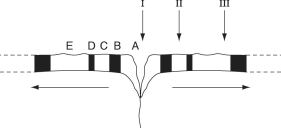The following questions refer to the description and figure below.
The figure represents a cross section of the sea floor through a mid-ocean rift valley, with alternating patches of black and white indicating sea floor with reversed magnetic polarities. At the arrow labeled "I" (the rift valley) , the igneous rock of the sea floor is so young that it can be accurately dated using carbon-14 dating. At the arrow labeled "III," however, the igneous rock is about 1 million years old, and potassium-40 dating is typically used to date such rocks. NOTE: the dashed horizontal arrows indicate the direction of sea-floor spreading, away from the rift valley.
 Figure 25.1
Figure 25.1
-On the basis of their morphologies, how might Linnaeus have classified the Hawaiian silverswords?
Definitions:
Actively Erupting
A volcanic state characterized by ongoing expulsion of lava, ash, or other volcanic material.
Conical-Shaped Hill
A landform with a circular base and sloping sides that converge to a point at the top, resembling the shape of a cone.
Fresh Ash Layers
Recent deposits of volcanic ash, consisting of fine particles of volcanic glass, created during volcanic eruptions.
Flat-Topped Mesa
A broad, flat, elevated landform with steep sides, commonly found in arid and semi-arid regions.
Q17: Carl Woese and collaborators identified two major
Q18: Review the roles of RNA by
Q21: Which of the following statements is True
Q22: Races of humans are unlikely to evolve
Q36: Homeotic genes<br>A)encode transcription factors that control the
Q45: Which of the factors below weaken the
Q61: Only certain prokaryotes can perform nitrogen fixation,
Q63: Which of these four gene parts should
Q64: Which of the following statements are True
Q85: A major evolutionary episode that corresponds in